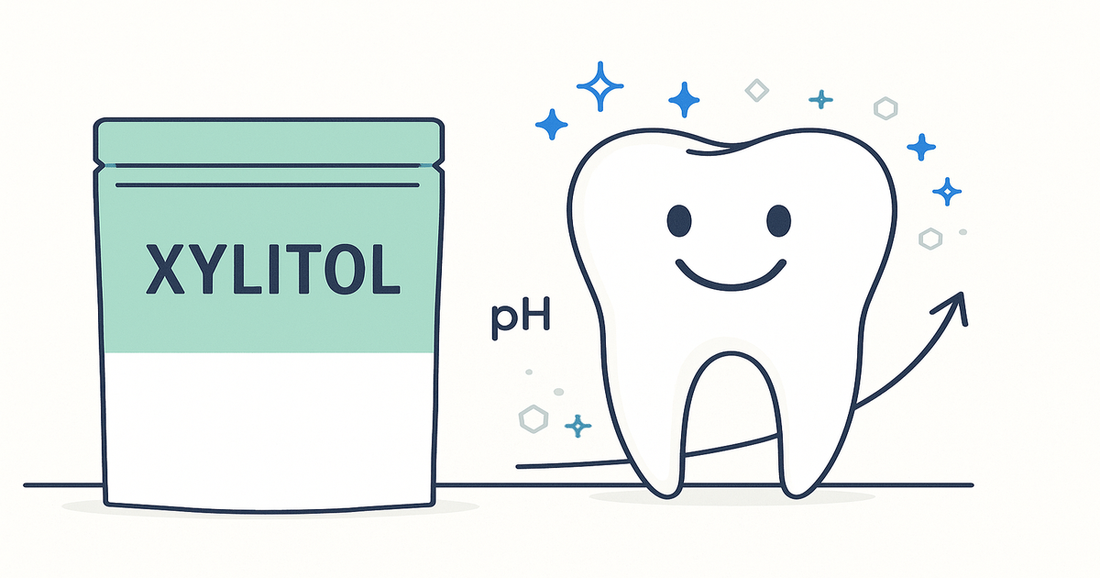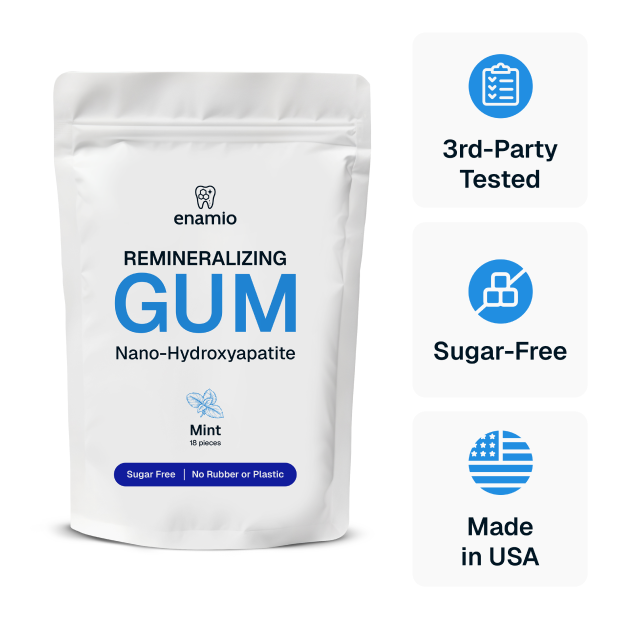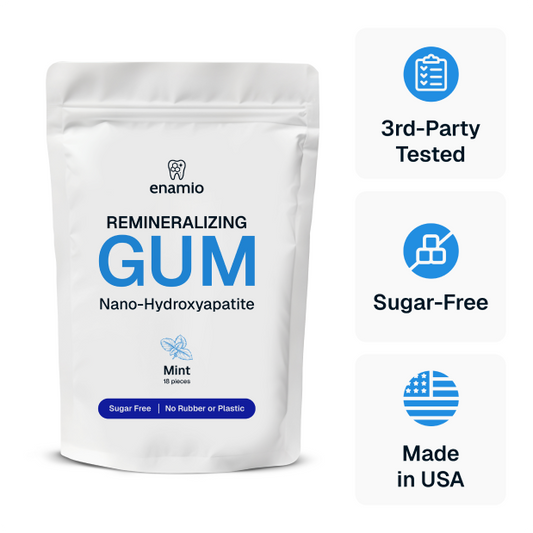
Xylitol for Oral Health: Benefits, Dosage & Safety | Enamio
Share
Xylitol for Oral Health: Benefits, Dosage, and Safety
A clinician-level guide to what xylitol can and can’t do, how much to chew, and how to pair it with enamel-strengthening actives for better results.

Key Takeaways
- Chewing sugar-free gum after meals helps saliva buffer acids and brings calcium and phosphate to the tooth surface [1][2].
- Xylitol resists acid production by oral bacteria during the chew and often reduces mutans streptococci in trials, though results vary [8].
- A practical xylitol target is 6–10 g per day split across 3–5 chews for 15–20 minutes after meals, in line with guidance and use patterns [2][7].
- Evidence for caries reduction with xylitol alone is mixed in modern reviews, so treat it as an adjunct, not a cure [4][14].
- Safety is broad in humans within normal food use; large single doses may cause GI upset. Keep all xylitol products away from dogs [6][9].
- Why Enamio adds more: we pair xylitol with ~20 nm nano-hydroxyapatite, calcium glycerophosphate, and arginine bicarbonate to support enamel rebuilding during the same post-meal window.
If you chew gum after meals, xylitol is an easy upgrade. This deep guide covers xylitol for oral health: benefits, dosage, and safety, how it compares with other sweeteners, and how to turn a simple chew into a remineralization habit.
The Problem
Every meal or sip of fermentable carbs can drop plaque pH below the safe zone for enamel. Critical pH for enamel dissolution hovers near 5.5 and depends on available calcium and phosphate in saliva [15][26]. Many of us snack often, chase coffee with juice, and graze through the day. That keeps pH low for longer.
We also live in a dry-mouth era. Medications, indoor air, and screen-time mouth-breathing cut salivary flow when we need it most. Less saliva means fewer buffers and fewer ions to patch up early enamel changes. Over months and years, those small losses add up.
Good news. Chewing sugar-free gum boosts saliva on demand and helps plaque pH recover after meals. It’s a simple habit that fits busy days [1][2].
The Science
1) Why sugar-free chewing helps right after meals
Chewing increases salivary flow several-fold during the first minutes of a chew. Saliva buffers acids, raises pH, and supplies calcium and phosphate that drive natural repair. The ADA recommends sugar-free gum after meals as part of a daily routine [1]. EFSA recognizes a cause-and-effect link between sugar-free gum and plaque acid neutralization with a practical plan: chew for 20 minutes after meals, at least three times daily [2].
Think of it as a small nudge. You blunt the acid curve, then flood the mouth with ions. That sets the stage for net mineral gain if minerals are available.
2) What makes xylitol different
Xylitol is a five-carbon polyol. Oral bacteria that love sucrose struggle to ferment it to acid, so acid production stays lower during the chew. Reviews report that xylitol gum often reduces mutans streptococci and can cut plaque compared with sorbitol gum or no gum, though not every study agrees [8].
That matters right after meals. Lower acid plus more saliva means a faster swing back toward neutral. Combine that with an ion source and you get better conditions for repair.
3) What strong evidence shows about cavities
Caries is multi-factorial. The 2015 Cochrane review found a modest reduction with a 10 percent xylitol toothpaste over 2.5–3 years but rated evidence for other formats lower [4]. In adults, the X-ACT trial of xylitol lozenges did not meet a clinically important or statistically significant reduction endpoint [14]. Gum is different from lozenges because chewing drives saliva, which is why major guidance centers on gum for pH recovery [1][2].
So treat xylitol as an adjunct. It supports the environment for repair and hygiene. It isn’t a stand-alone cure.
4) Dose, frequency, and timing
Policy and program data cluster around a daily total near 6–10 g split into several uses. The AAPD policy summarizes program doses from about 4 to 15 g per day across 3–7 exposures, with better outcomes at realistic totals and steady patterns [7]. EFSA’s practical pattern is 20 minutes after meals at least three times daily [2].
Chew time matters. Plan for 15–20 minutes when acids peak. That is the same window when salivary buffering, ion delivery, and biofilm shifts can work together.
5) Format matters: gum vs lozenges
Lozenges can deliver xylitol, but gum adds continuous chewing and saliva stimulation. That is why ADA and EFSA guidance centers on gum for pH recovery [1][2]. The X-ACT lozenge study is a useful contrast. It shows that format and program design influence outcomes [14].
6) Safety and tolerance
JECFA lists xylitol with “ADI not specified,” reflecting a wide safety margin within normal food use [6][27]. At high single intakes, some people report GI symptoms. In trials with large liquid loads, symptoms increased above roughly 35–50 g in unaccustomed adults [10]. That is far above oral-care dosing. Start low and spread intake across the day if you’re sensitive.
Keep all xylitol products away from dogs. FDA warns that even small exposures can be dangerous and fast-acting in pets [9][12].
7) Why pairing xylitol with minerals improves the play
Chewing is a unique delivery system for enamel donors. In situ and clinical research shows that gums supplying bioavailable calcium and phosphate can raise plaque-fluid calcium, elevate pH after sugar, and enhance remineralization of early lesions [16][17][18][25].
Calcium glycerophosphate and calcium lactate are standouts. Both increase free calcium in plaque fluid during the chew. Studies and reviews report better remineralization metrics or higher saturation indices vs control gum [16][17][18].
Nano-hydroxyapatite (n-HA) adds tooth-identical crystals. Recent randomized trials show non-inferiority to fluoride dentifrices for caries prevention in adults and high-risk groups, supporting its role as a mineral donor in everyday care [19][20][21].
8) Arginine helps biofilm pH homeostasis
Arginolytic bacteria use arginine via the ADS pathway to produce alkali that nudges plaque pH upward. Clinical and translational studies associate higher ADS activity with lower caries risk and faster pH recovery. Formulations with arginine sources can help tip biofilm ecology toward neutral [22][23][24].
Xylitol for Oral Health: Benefits, Dosage, and Safety | quick facts
- What it does: supports pH recovery during the chew and often reduces mutans streptococci load in trials [8].
- How much: plan for 6–10 g per day split into 3–5 chews for 15–20 minutes after meals [2][7].
- What it doesn’t do: xylitol alone doesn’t supply minerals. Combine it with mineral donors for early lesion repair [16][19].
- Safety: broad in humans with normal use. Keep away from dogs. Introduce gradually if you have a sensitive gut [6][10][9].
How Enamio Works
Enamio is a natural remineralizing gum designed for the 15–20 minute window after you eat. We start with a plastic-free sap base so you actually want to chew daily. Then we layer actives that work together while saliva is flowing and plaque pH recovers.
- Nano-hydroxyapatite (~20 nm): tooth-identical crystals that can integrate with early enamel defects during the chew. Trials show hydroxyapatite dentifrices can prevent caries on par with fluoride in adults and high-risk groups [19][20][21].
- Calcium glycerophosphate: bioavailable calcium-phosphate donor that raises plaque-fluid calcium and promotes remineralization during sugar challenges [16][17].
- L-Arginine bicarbonate (ADS): a substrate for alkali production by health-linked bacteria that can improve pH homeostasis [22][24].
- Xylitol USP: resists fermentation to acids and supports favorable plaque ecology during the chew [8].
- Matcha green tea extract, zinc, magnesium, bamboo silica, natural mint: supportive antioxidants and minerals for a clean, fresh chew.
Here is why this stack helps. Right after you eat, acids rise, then saliva fights back. That is the perfect moment to bathe enamel in ions and nudge biofilm chemistry toward neutral. Enamio is built for that moment.
Strengthen Your Enamel, Anytime
Make your after-meal habit count with xylitol plus enamel minerals.
Shop Enamio: Xylitol for Oral Health: Benefits, Dosage, and Safety
How to Use
Daily routine you can stick to
- When: right after meals or snacks, chew one piece for 15–20 minutes. This aligns with ADA and EFSA guidance for acid neutralization [1][2].
- How much xylitol: target a total of 6–10 g per day split across 3–5 chews. That mirrors policy summaries and many clinical programs [7].
- Pairing: choose a gum that also supplies enamel donors and arginine. That is how you convert a pH habit into a remineralization habit [16][22].
Dosage math in real life
Per-piece xylitol varies by brand. Some sugar-free gums use blends and list “xylitol” without a gram amount. When grams per piece appear, the range is often 0.5–1.0 g. If your goal is 6–10 g per day, plan your pieces accordingly and spread them out to lower the chance of GI discomfort [10].
Protocol examples
- Standard days: one piece after breakfast, lunch, and dinner for 15–20 minutes each time.
- Coffee or citrus days: wait a few minutes, then chew for 20 minutes. Add minerals during that window to support repair before you brush later [2][16].
- Dry mouth support: split chews into shorter sessions through the day for comfort. Keep water handy and coordinate with your dental team.
- Orthodontics: choose a soft chew and shorten time if jaw muscles fatigue. Chewing still helps buffer acids caught under wires and attachments [1].
Common mistakes to avoid
- Chewing for only a minute or two. You miss the 15–20 minute saliva curve [2].
- Relying on xylitol alone for repair. You still need mineral donors for early lesions [16][19].
- Pushing intake in one large session. Spread it out to keep comfort high [10].
Enamio vs Competitors
Let’s break it down. Many gums use xylitol to keep the chew sugar-free. Fewer add bioavailable minerals or arginine. This table compares common brands and the practical benefit you can expect.
| Brand | Base / Sweetener | Key Active(s) | Mechanism & Evidence | Practical Benefit |
|---|---|---|---|---|
| Enamio | Chicle/candelilla; xylitol + monk fruit | ~20 nm nano-HA, CaGP, arginine bicarbonate, xylitol, matcha, zinc, magnesium | Sugar-free chewing and xylitol support pH [1][2]; n-HA and CaGP supply ions during the chew [16][19]; arginine supports biofilm pH homeostasis [22]. | pH support plus mineral rebuild in one chew. |
| Nathan & Sons Underbrush | Tree resin base; xylitol blend | Hydroxyapatite noted on some labels | Mineral mention is promising. Per-piece mineral load and particle size are key for results. | Mineral-leaning option; check label details. |
| Underbrush | Tree resin blend; xylitol + erythritol | Hydroxyapatite listed on some SKUs | Likely provides mineral support. Verify per-piece actives and sweetener grams. | Check transparency before you buy. |
| Refresh Gum | Chicle; xylitol | Xylitol; some SKUs add botanicals | Sugar-free chewing and xylitol for pH support [2]. | Freshening plus pH support; minimal mineral donors. |
| Simply Gum (Sugar-Free) | Chicle; xylitol | Xylitol | Sugar-free chewing benefits apply [1][2]. | Clean label chew; limited remineralization actives. |
| Glee Gum (Sugar-Free) | Chicle; xylitol | Xylitol focus | Supports pH recovery with sugar-free chew [2]. | Sugar-free everyday choice. |
| True Gum | Plastic-free base; xylitol | Xylitol with stevia on some SKUs | Sugar-free gum mechanism; check labels for actives [2]. | Clean base; minimal mineral donors. |
| Spry | Xylitol-forward brand | Xylitol (per-piece grams vary) | Adjunct benefits for plaque bacteria reported in reviews [8]. | Great for sugar-free chewers; watch totals. |
| PUR | Plastic-free base; xylitol | Xylitol | Sugar-free chewing mechanism applies [2]. | Simple sugar-free option; few remineralizers. |
Bottom line: if you want enamel support, choose a gum that brings minerals and arginine to the same 20-minute window as your xylitol chew. That is where Enamio stands out.
People Also Ask
Is xylitol good for teeth?
Yes, as part of a routine. Chewing sugar-free gum with xylitol after meals supports saliva flow and resists acid production, which helps pH recovery. The strongest cavity data come from full programs, not xylitol alone, so keep brushing, flossing, and seeing your dentist [1][2][4].
What is the ideal xylitol dosage for oral health?
A realistic range is 6–10 g per day split into several chews. Aim for 15–20 minutes after meals. Policies summarize program doses of roughly 4–15 g per day with multiple exposures. Consistency matters more than one big chew [2][7].
Does xylitol gum rebuild enamel?
Not by itself. Xylitol helps create a friendlier environment for repair, but it doesn’t deliver minerals. To rebuild early, non-cavitated lesions, combine xylitol with mineral donors such as nano-hydroxyapatite or calcium glycerophosphate during the post-meal window [16][19].
Is xylitol safe?
Yes within normal food use. JECFA lists an “ADI not specified,” which signals wide safety margins. Large single doses can cause GI symptoms in unaccustomed users. Keep all xylitol away from dogs due to veterinary toxicity risks [6][10][9].
How long should I chew?
About 15–20 minutes after meals. That matches both saliva dynamics and the EFSA pattern for plaque acid neutralization. Adjust for jaw comfort [1][2].
Xylitol for oral health: benefits, dosage, and safety for kids?
For children able to chew gum safely, xylitol can be part of a caries-prevention plan. Evidence is mixed, dose and frequency matter, and chewing never replaces brushing or flossing. Work with your dentist and keep all xylitol away from pets [7][1].
FAQs
How does xylitol compare to sorbitol or erythritol?
What about stomach issues?
Fluoride vs nano-hydroxyapatite vs xylitol
Can I overdo xylitol?
Does the gum base matter?

Rebuild Support, On the Go
High nano-hydroxyapatite load with CaGP, arginine, xylitol, and matcha extract in a plastic-free base you’ll actually chew.
Reading Next
- Does Xylitol Gum Remineralize Teeth? Learn why xylitol helps the conditions for repair and where minerals fit in.
- Nano Hydroxyapatite Gum: The Science-Backed Way See what ~20 nm particles do during the chew.
- What Is the Best Remineralizing Gum? Use a simple checklist for label reading.
Written by Enamio Science Review Team
Our team reviews current evidence on remineralization and safer sweeteners so you can make informed choices.
References
- Chewing Gum, American Dental Association (MouthHealthy), 2025, https://www.mouthhealthy.org/all-topics-a-z/chewing-gum
- Scientific Opinion: Sugar-free chewing gum and neutralisation of plaque acids, European Food Safety Authority, 2010, https://www.efsa.europa.eu/en/efsajournal/pub/1776
- Diet and Dental Health, ADA MouthHealthy, 2025, https://www.mouthhealthy.org/all-topics-a-z/diet-and-dental-health
- Xylitol-containing products for preventing dental caries in children and adults, Cochrane, 2015, https://www.cochranelibrary.com/cdsr/doi/10.1002/14651858.CD010743.pub2/abstract
- Chewing sugarless gum for 20 minutes can help prevent tooth decay, ADA resource PDF, 2010, https://www.mouthhealthy.org/~/media/ADA/Publications/Files/for_the_dental_patient_dec_2010.pdf
- JECFA Evaluation: Xylitol — ADI not specified, WHO/FAO JECFA, 1983 with updates, https://www.inchem.org/documents/jecfa/jeceval/jec_2404.htm
- Policy on Use of Xylitol in Pediatric Dentistry, American Academy of Pediatric Dentistry, 2024, https://www.aapd.org/research/oral-health-policies--recommendations/use-of-xylitol/
- Xylitol chewing gum/candies and plaque accumulation: systematic review, Clinical Oral Investigations, 2021, https://pmc.ncbi.nlm.nih.gov/articles/PMC8791908/
- Paws Off! Xylitol is Toxic to Dogs, U.S. FDA Animal & Veterinary, 2025, https://www.fda.gov/animal-veterinary/animal-health-literacy/paws-xylitol-toxic-dogs
- Gastrointestinal tolerance of erythritol and xylitol ingested in a liquid, European Journal of Clinical Nutrition, 2007, https://pubmed.ncbi.nlm.nih.gov/16988647/
- Sugar-free gum and dental plaque reduction, EFSA Opinion 1480, 2010, https://www.efsa.europa.eu/en/efsajournal/pub/1480
- Foods People Eat That Are Bad for Your Dog, FDA Consumer Update, 2021, https://www.fda.gov/consumers/consumer-updates/good-dog-bad-food-foods-people-are-bad-your-dog
- ADA Nutrition page on dry mouth tips, 2025, https://www.mouthhealthy.org/nutrition/nutrition-concerns
- Results from the Xylitol for Adult Caries Trial (X-ACT), JADA, 2013, https://pmc.ncbi.nlm.nih.gov/articles/PMC3926805/
- What is the critical pH and why does a tooth dissolve in acid?, JCDA, 2003, https://www.cda-adc.ca/jcda/vol-69/issue-11/722.pdf
- Effects of various forms of calcium added to chewing gum, Caries Research review, 2007, https://pubmed.ncbi.nlm.nih.gov/17284911/
- The effect of chewing gums containing calcium phosphates on remineralization, Caries Research, 2005, https://pubmed.ncbi.nlm.nih.gov/15914989/
- Composition of plaque and saliva following α-TCP gum, Journal of Dental Research, 1998, https://pubmed.ncbi.nlm.nih.gov/9496925/
- Microcrystalline hydroxyapatite not inferior to fluoride for caries prevention, J Dent Res trial summary/PMC, 2019, https://pmc.ncbi.nlm.nih.gov/articles/PMC6590169/
- Caries-preventing effect of a hydroxyapatite toothpaste in adults, Frontiers in Public Health, 2023, https://pmc.ncbi.nlm.nih.gov/articles/PMC10393266/
- Comparative efficacy of hydroxyapatite and fluoride toothpaste, Europe PMC record, 2019, https://europepmc.org/article/med/31839988
- The effect of arginine on oral biofilm communities, Journal of Dental Research, 2014, https://pubmed.ncbi.nlm.nih.gov/24289808/
- Oral arginine metabolism may decrease caries risk, Current Oral Health Reports, 2013, https://pmc.ncbi.nlm.nih.gov/articles/PMC3684231/
- Arginine improves pH homeostasis via community remodeling, Journal of Dental Research, 2017, https://pmc.ncbi.nlm.nih.gov/articles/PMC5502959/
- The effect of a dicalcium phosphate chewing gum on caries incidence in children, JADA, 1967, https://pubmed.ncbi.nlm.nih.gov/4381314/
- Composition and cariogenic potential of dental plaque fluid, JDR, 1994, https://pubmed.ncbi.nlm.nih.gov/7999948/
- What “ADI not specified” means, WHO Food Additives Series, 2000, https://www.inchem.org/documents/jecfa/jecmono/v18je01.htm

